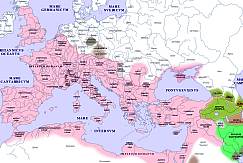 Virtual Catalog of Roman Coins
Virtual Catalog of Roman Coins Virtual Catalog of Roman Coins
Virtual Catalog of Roman Coins

An Online Encyclopedia of Roman Emperors
Victorinus (A.D. 269-271)
Michel Polfer
Centre Universitaire de Luxembourg
A soldier of considerable ability (Aur. Vict. Caes. 33.12), Marcus Piav(v)onius Victorinus[[1]] had a brilliant career under the first emperor of the so-called Gallic Empire, Postumus. In 266/267 A.D., Victorinus held the office of tribunus praetorianorum,[[2]] and in 267 or 268 he shared the eponymous consulship with Postumus.[[3]] Victorinus' name suggests a provincial, western origin;[[4]] the activity of his mother after his death (see below) suggests considerable family wealth.[[5]] After the short reign of Marius, Victorinus was proclaimed emperor of the Gallic Empire in autumn of the year 269 (before the 10th of December) by the troops in Augusta Treverorum (Trier). He was recognized in Gaul and in Britain, but not in Spain.[[6]] The capital and the main mint of Victorinus was Cologne; it is possible that he also minted coins in Trier.[[7]]
It seems that most of Victorinus' activity was directed towards the recovering of territories of the Imperium Galliarum already lost to the Central Empire. He did not take any steps to extend the territory under his control beyond Gaul and Britain. The troubles Victorinus faced in Gaul culminated in the rebellion of Augustodunum Haeduorum (Autun), which declared itself for Claudius Gothicus ( Paneg. lat. 8.2.5 and 8.4.2-3 ed. Galletier; Ausonius, Parentalia 15.6.8-10).[[8]] In the summer of 270, after a siege of seven months, the troops of Victorinus managed to take, plunder, and partially destroy the city (Paneg. lat. 5.4.2-3; 5.9).
After his success against Autun, Victorinus returned in triumph to the north and took residence in Cologne. A few months later, in early 271, Victorinus was murdered there by one of his own officers, the quartermaster Attitianus, apparently for reasons of private revenge.[[9]] His mother Victoria still held enough authority among the troops of the Gallic Empire to impose his deification and to decide the question of his succession. She bribed the troops in order to arrange their support for her nominee, the governor of Aquitania C. Pius Esuvius Tetricus ( Aur. Vict. 33.14 ; Tyr. trig. 24.1-5) .
Bibliography:
1) Primary Sources :
Aurelius Victor, Liber de Caesaribus (33.12), ed. F. Pichlmayr, Leipzig, 1911 (reprinted 1970).
Ausonius, Parentalia (15.6.8-10) ed. H.G. Evelyn-White (Loeb), London, 1919.
Eutropius, Breviarium (9.9), ed. C. Santini, Leipzig, 1979.
Scriptores Historae Augustae Tyranni triginta, 6.3, ed. E. Hohl, Leipzig, 1927.
Panegyrici Latini ed. R. Galletier , Paris, 1949-55, V (9) 4.1; VIII (5) 4.2f..
2) Secondary Sources :
Drinkwater 1987 : J. F. Drinkwater, The Gallic Empire. Separatism and Continuity in the North-Western Provinces of the Roman Empire A.D. 260-274, Stuttgart, 1987 (= Historia Einzelschriften Heft 52).
Elmer 1941 : G. Elmer, Die Münzprägung der gallischen Kaiser von Postumus bis Tetricus in Köln, Trier und Mailand, in : Bonner Jahrbücher 146, 1941, 1-106.
Kienast 1990 : D. Kienast, Römische Kaisertabelle. Grundzüge einer römischen Kaiserchronologie, Darmstadt, 1990.
Lafaurie 1975 : J. Lafaurie, L'Empire gaulois. Apport de la numismatique, in : Aufstieg und Niedergang der Römischen Welt II, 2, Berlin, New York, 1975, 853-1012.
König 1981 : I. König, Die gallischen Usurpatoren von Postumus bis Tetricus, München 1981.
PIR P 302 (Victorinus) and PIR V 430 (his mother Victoria).
PLRE 965 Nr. 12 (Victorinus) and PLRE 961f. (his mother Victoria).
RE VIII A 2, 1958, 2074ff. Nr. 2 (R. Hanslik) (Victorinus) and RE VIII A 2, 1958, 2071 Nr. 4 (R. Hanslik) (his mother Voctoria).
Schulte 1983 : B. Schulte, Die Goldprägung der gallischen Kaiser von Postumus bis Tetricus, Aarau, Frankfurt a. M., Salzburg, 1983.
Schulzki 1996 : H.-J. Schulzki, Die Antoninianenprägung der gallischen Kaiser von Postumus bis Tetricus (AGK) : Typenkatalog der regulären und nachgeprägten Münzen, Bonn, 1996 ( = Antiquitas 3, 35).
Notes:
[[1]] Some of the inscriptions give his name as M. Piavvonius Victorinus (e.g., CIL XIII.8958), as does the first emission of coins from the Cologne mint. A mosaic from Trier (see note 2) has him as Piaonius.
[[2]] CIL XIII.3679, a mosaic reading M. Piaonius Victorinus, tribunus pret(oria)norum, was discovered in Trier.
[[3]] CIL II.5736.
[[4]] Drinkwater 1987, 35 and 126.
[[5]] It is not known whether Victorinus' wealth was old, acquired while he served Postumus, or gained during his reign. See König 1981, 158.
[[6]]It is most likely that the desertion of Spain from the Gallic Empire was initiated by the troops of the legio VII Gemina. See Drinkwater 1987, 36-37 and 211.
[[7]]Drinkwater 133ff and esp. 145, where he discusses the numismatic evidence on the different mints in use under the Gallic Emperors.
[[8]]König 1981,146 has hypothesized an unsuccessful rebellion in Britain against Victorinus. The theory rests only on the reconstruction of an inscription (RIB 2246) from one meager fragment, and has been rightly rejected by Drinkwater 1987, 121. He considers that apart from Spain and eastern Narbonnensis, the rest of the Gallic Empire remained loyal to Victorinus.
[[9]] Most of our sources (SHA Tyr. trig. 6.3; Aur. Vict. 33.12; Eutr. 9.9.) give Victorinus a reputation of being a womanizer and report that when he tried to seduce the wife of Attitianus, Attitianus arranged for his murder. The fact that his mother Victoria was able to impose Tetricus I as his successor also suggests that he was murdered for private reasons. (Drinkwater 38 and 52f., 90 and 182).
Copyright (C) 1999, Michel Polfer. This file may be copied on the condition that the entire contents, including the header and this copyright notice, remain intact.
Comments to: Michel Polfer.
Updated:3 June 2000
For more detailed geographical information, please use the DIR/ORBAntique and Medieval Atlas below. Click on the appropriate part of the map below to access large area maps.
